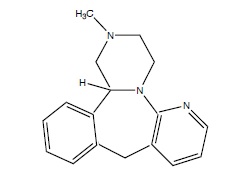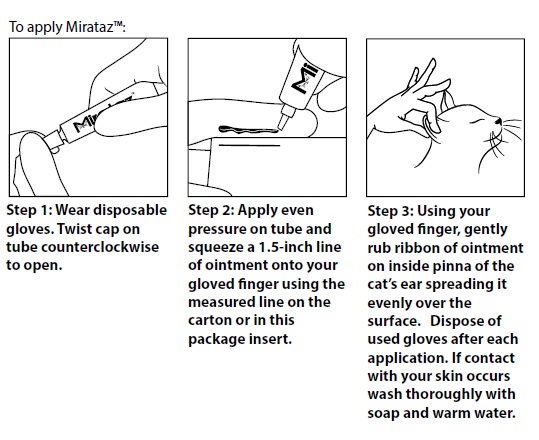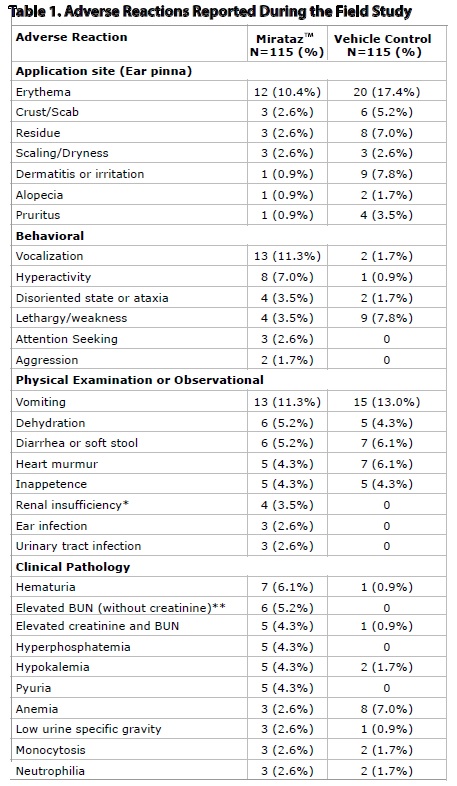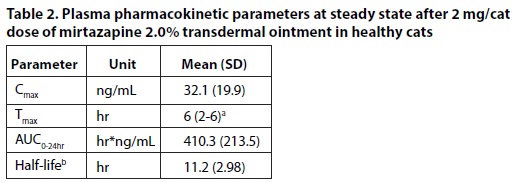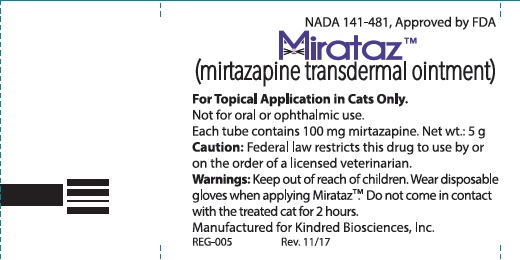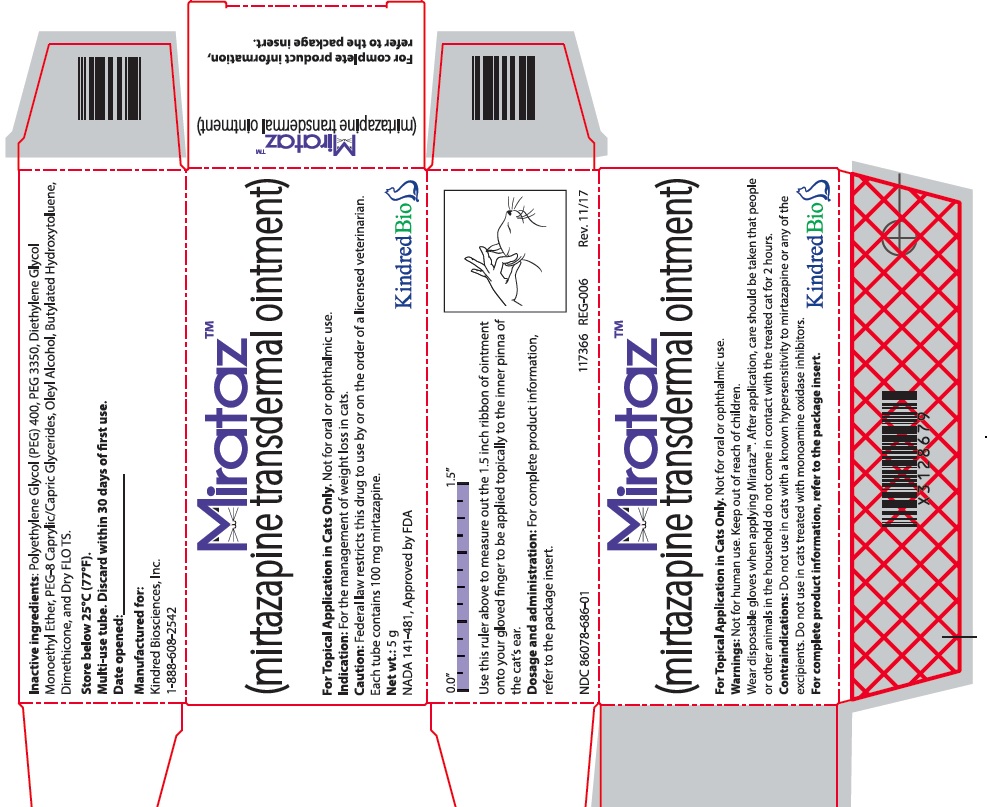MIRATAZ- mirtazapine ointment
Kindred Biosciences, Inc.
----------
Mirataz™
(mirtazapine transdermal ointment)
Each 1 g of Mirataz™ contains 20 mg mirtazapine (2%). Each 5 g tube contains 100mg (0.1 g) of mirtazapine.
For topical application in cats only. Not for oral or ophthalmic use.
CAUTION:
Federal law (USA) restricts this drug to use by or on the order of a licensed veterinarian.
DESCRIPTION:
Mirataz™ (mirtazapine transdermal ointment) is a white to off-white ointment containing 2% (w/w) of mirtazapine suitable for transdermal (topical) administration. Mirataz™ contains the following inactive ingredients: Polyethylene Glycol (PEG) 400, PEG 3350, Diethylene Glycol Monoethyl Ether, PEG-8 Caprylic/Capric Glycerides, Oleyl Alcohol, Butylated Hydroxytoluene, Dimethicone, and Dry Flo TS.
The structural formula of mirtazapine is:
Molecular Formula: C17H19N3 MolecularWeight: 265.35
DOSAGE AND ADMINISTRATION:
Administer topically by applying a 1.5-inch ribbon of ointment (approximately 2 mg/cat) on the inner pinna of the cat's ear once daily for 14 days (see Diagrams below).
Wear disposable gloves when applying Mirataz™. Dispose of used gloves after each application.
Alternate the daily application of Mirataz™ between the left and right inner pinna of the ears. Do not administer into the external ear canal. If desired, the inner pinna of the cat's ear may be cleaned by wiping with a dry tissue or cloth immediately prior to the next scheduled dose. If a dose is missed, apply Mirataz™ the following day and resume daily dosing.
To demonstrate the method of administering the dose, the veterinarian or trained personnel at the clinic should apply the first dose in the presence of the owner.
This ruler measures 1.5 inches. Use this ruler to measure the 1.5 inch ribbon of ointment to be applied.
CONTRAINDICATIONS:
Mirataz™ is contraindicated in cats with a known hypersensitivity to mirtazapine or to any of the excipients.
Mirataz™ should not be given in combination, or within 14 days before or after treatment with a monoamine oxidase inhibitor (MAOI) [e.g. selegiline hydrochloride (L-deprenyl), amitraz], as there may be an increased risk of serotonin syndrome.
HUMAN WARNINGS:
Not for human use. Keep out of reach of children.
Wear disposable gloves when handling or applying Mirataz™ to prevent accidental topical exposure. After application, dispose of used gloves and wash hands with soap and water. After application, care should be taken that people or other animals in the household do not come in contact with the treated cat for 2 hours because mirtazapine can be absorbed transdermally and orally. However, negligible residues are present at the application site and the body of the cat at 2 hours after dosing.
In case of accidental skin exposure, wash thoroughly with soap and warm water. In case of accidental eye exposure, flush eyes with water. If skin or eye irritation occurs seek medical attention.
In case of accidental ingestion, or if skin or eye irritation occurs, seek medical attention.
PRECAUTIONS:
Do not administer orally or to the eye.
Use with caution in cats with hepatic disease. Mirtazapine may cause elevated serum liver enzymes (See Animal Safety).
Use with caution in cats with kidney disease. Kidney disease may cause reduced clearance of mirtazapine which may result in higher drug exposure.
Upon discontinuation of Mirataz™, it is important to monitor the cat's food intake. Food intake may lessen after discontinuation of mirtazapine transdermal ointment. If food intake diminishes dramatically (>75%) for several days, or if the cat stops eating for more than 48 hours, reevaluate the cat.
Mirataz™ has not been evaluated in cats < 2 kg or less than 6 months of age. The safe use of Mirataz™ has not been evaluated in cats that are intended for for breeding, pregnant, or lactating cats.
ADVERSE REACTIONS:
In a randomized, double-masked, vehicle-controlled field study to assess the effectiveness and safety of mirtazapine for the management of weight loss in cats, 115 cats treated with Mirataz™ and 115 cats treated with vehicle control were evaluated for safety. The vehicle control was an ointment containing the same inert ingredients as Mirataz™ without mirtazapine. The most common adverse reactions included application site reactions, behavioral abnormalities (vocalization and hyperactivity), and vomiting. The adverse reactions observed in the study and
number of cats experiencing each adverse reaction is summarized in Table 1 below.
* One cat with renal insufficiency was reported with a serious adverse reaction of acute renal failure, hematuria, and pyuria at the Week 2 visit. The cat was enrolled with a history of chronic kidney disease. Euthanasia was elected and necropsy revealed hypertrophic cardiomyopathy, bilateral parathyroid hyperplasia, and mild to moderate renal disease.
** At Week 2, blood urea nitrogen (BUN) values were significantly higher in the Mirataz™ group compared to the vehicle control group (p<0.10). The BUN in the Mirataz™ group was 43.60 mg/dL (reference range 16-37 mg/dL) compared to 36.05 mg/dL in the vehicle control group.
Post study, follow-up was done in 199 cats (103 in the Mirataz™ (mirtazapine transdermal ointment) group and 96 in the vehicle control group). Following cessation of Mirataz™, four cats were reported as being less social or less restless, one cat was reported as more active, and one cat was reported with increased hissing and urinating out of the litter box.
To report suspected adverse events, for technical assistance or to obtain a copy of the SDS, contact Kindred Biosciences, Inc. at 888-608-2542.
For additional information about adverse drug experience reporting for animal drugs, contact FDA at 1-888-FDA-VETS or online at http://www.fda.gov/AnimalVeterinary/SafetyHealth
INFORMATION FOR CAT OWNERS:
Upon discontinuation of Mirataz™, it is important to monitor your cat's food intake.
Your cat's food intake may lessen after discontinuation of mirtazapine transdermal ointment. If food intake diminishes dramatically (>75%) for several days or if your cat stops eating for more than 48 hours, contact your veterinarian.
CLINICAL PHARMACOLOGY:
Mechanism of Action:
The exact mechanism by which mirtazapine induces weight gain has not been clearly elucidated but appears to be multifactorial.1 Mirtazapine is an α2-adrenergic receptor antagonist nor-adrenergic and serotonergic antidepressant drug. Mirtazapine is known to be a potent antagonist of 5-HT2 and 5-HT3 serotonin receptors in the central nervous system (CNS), and a potent inhibitor of histamine H1 receptors. Because mirtazapine blocks 5-HT2 and 5-HT3 receptors, only 5-HT1A- mediated serotonergic transmission is enhanced. Inhibition of 5-HT2 receptors may account for the orexigenic effects of mirtazapine. Another hypothesis is that mirtazapine induced weight gain may be secondary to changes in
leptin and the tumor necrosis factor α(TNF-α) cytokine system.2 A study by Fernstorm (1995) demonstrated a reduction of the basal metabolic rate in patients treated with antidepressants in general.3
Pharmacokinetics:
In a crossover study in eight cats to determine the relative bioavailability of oral and transdermal 2% mirtazapine, the mean half-life (26.8 hours) with topical administration was over 2X longer than the mean half-life (10.1 hours) with oral administration.
The doses used in the target animal safety study were higher (2.8 to 5.4 mg) than the label dose. Based on dose proportionality in AUC0-24hr and Cmax observed in this study, these pharmacokinetic parameters were extrapolated for the 2 mg/cat label dose administered once per day for 35 days (see Table 2).
Steady state was achieved within 14 days. The median accumulation between first and 35th dose was 3.71X (based on AUC ratio) and 3.90X (based on Cmax ratio).
Cmax = extrapolated maximum plasma concentration
aTmax= time to maximum plasma concentration (reported as median and range) AUC0-24hr = extrapolated area under the plasma time vs. concentration curve
b The half-life value is reflective of both topical and oral exposure. In another study where cats wore Elizabethan collar to restrict access to their ears and consequent oral exposure, a longer half-life (Mean= 20.7 hr) was observed
EFFECTIVENESS:
The effectiveness of Mirataz™ (mirtazapine transdermal ointment) was demonstrated in a randomized, double-masked, vehicle-controlled, multi-site field study involving client-owned cats of various breeds.
Enrolled cats were ≥1 year of age and had existing documented medical history of ≥5% weight loss deemed clinically significant. The most common pre-existing conditions included renal insufficiency, vomiting, and hyperthyroidism. Some cats had more than one pre-existing condition. Cats were randomized to treatment groups in a 1:1 ratio of Mirataz™ to vehicle control. A total of 230 cats were enrolled and received either Mirataz™ (115 cats) or a vehicle control (115 cats) containing the same inert ingredients without mirtazapine. The cats were 2.8-24.6 years of age and weighed 2.1-9.2 kg. The dosage was a 1.5-inch ribbon (approximately 2 mg/cat) mirtazapine or vehicle ointment administered topically to the inner pinna of the cat's ear.
A total of 177 cats were determined to be eligible for the effectiveness analysis; 83 cats were in the Mirataz™ group and 94 cats were in the vehicle control group. The primary effectiveness endpoint was the mean percent change in body weight from Day 1 to the Week 2 Visit. At Week 2, the mean percent increase in body weight from Day 1 was 3.94% in the mirtazapine group and 0.41% in the vehicle control group. The difference between the two groups was significant (p<0.0001) based on a two-sample t-test assuming equal variances. A 95% confidence interval on the mean percent change in body weight for the Mirataz™ group is (2.77, 5.11), demonstrating that the mean percent change is statistically different from and greater than 0.
ANIMAL SAFETY:
The margin of safety of mirtazapine was evaluated in one laboratory study, a comprehensive review of six pilot studies (five laboratory and one clinical) utilizing the final market formulation, and one laboratory study that was not final market formulation.
Laboratory Safety Study:
In a 6-week laboratory safety study, 48 healthy cats aged 7-10 months were dosed topically with mirtazapine once daily at 0 mg/kg (vehicle control), 1.1 mg/kg (1.4 to 2.7X), 3.2 mg/kg (4.3-7.5X), and 5.3 mg/kg (7.1-12.2X) body weight. Four cats/sex/group in the 1.1 and 3.2 mg/kg groups were dosed topically to the inner pinna of the ear, alternating between right and left ears. Eight cats/sex/group in the 0 and 5.3 mg/kg groups were dosed topically to the inner pinna of the ear, splitting the dose between both ears. Four cats/sex/group in the 0 and 5.3 mg/kg groups were maintained and monitored during a 4-week recovery period.
6 Week Dosing Period
Application of mirtazapine and vehicle control was associated with ear flicking, head shaking, pulling away/flinching and infrequently with struggling/fractious behavior, and hypersalivation. Inner and outer pinna erythema, flaking, alopecia, and thickening were observed in all cats in all groups. Erythema, crusting, alopecia, and scabbing of the skin, mostly around the head and neck, was frequently observed in all groups and occasionally affected the tail, tarsi or carpi, likely due to spread of the ointment to these areas by self-grooming.
Mirtazapine administration resulted in increased vocalization, hyperactivity, attention-seeking behaviors, and tremors in all mirtazapine dose groups. Frank blood in the stool was infrequently observed in the vehicle control, 3.2, and 5.3 mg/kg groups. Polyuria was observed in all groups. Polydipsia was observed in one cat in the 5.3 mg/kg group. Three cats (one from each mirtazapine dose group) were isosthenuric. Eight cats developed cystitis with or without urethral obstruction throughout the study in all groups. One cat each from the vehicle control and 3.2 mg/kg group were euthanized early on Day 35 due to urethral obstruction.
Two cats from the 1.1 mg/kg group had either ventricular premature contractions (VPC) or tall R waves, and one cat from the 5.3 mg/kg group had both VPC and a right axis deviation.
Eosinophilia was noted sporadically in the vehicle control, 1.1, and 5.3 mg/kg groups. Mild elevations in ALT values were noted sporadically in vehicle control, 3.2, and 5.3mg/kg groups. On Day 15, one cat in the 3.2mg/kg group demonstrated a marked ALT elevation of 3397 U/L, with concurrent elevations in AST and GGT. By Day 42, the ALT declined to 109 U/L and the AST and GGT returned to within normal limits.
Gross pathology findings, confirmed with histopathology, were hyperplastic dermatitis (alopecia, hyperkeratosis, thickening, and ceruminous gland secretion) of the pinnae in all cats and findings consistent with cystitis (mucosal urinary bladder hemorrhage, mottled-dark red appearance, and irregular contour) in four male cats (two vehicle control, one 3.2 mg/kg and one 5.3 mg/kg). Additional histopathologic findings included pyelonephritis (two vehicle control and one 5.3 mg/kg), nephrocalcinosis (three vehicle control, one 1.1 mg/kg, three 3.2 mg/kg, and one 5.3 mg/kg), necrosis of the kidneys (one vehicle control and one 3.2 mg/kg), unilateral hypoplasia of the thyroid gland (two 5.3 mg/kg), and unilateral hypertrophy of the thyroid gland (one 5.3 mg/kg).
4 Week Recovery Period
Following a 4-week recovery period, ALT elevations resolved. Polyuria was reduced and only occurred in two cats in the 5.3 mg/kg group. Pinnal lesions (erythema and flaking) completely resolved in the vehicle control and improved in the 5.3 mg/kg groups. Ear thickening improved in both groups.
Pilot Safety Studies:
In six pilot studies (five laboratory and one clinical study) utilizing the final market formulation of Mirataz™, and one laboratory study that utilized non-final market formulation, a total of 76 cats were administered mirtazapine. Five studies administered mirtazapine ointment topically (0.5-5.3 mg/kg), one study administered mirtazapine topically and orally (0.5 mg/kg), and one study administered mirtazapine
orally (10.6 mg/cat).
The most common observations were ear pinnae reactions (erythema with or without blood and flaking), mild behavioral observations (vocalization and tremors), vomiting, and diarrhea.
One study reported six cats with blood in the stool. Two studies reported one cat each showing aggression. One study reported polyuria in one cat; another study reported stranguria and possible urinary tract infection in one cat. Two studies reported cardiac abnormalities, including sinus tachycardia not present at baseline, development of a grade 3/6 heart murmur, tall QRS complexes, and left or right axis deviation. One study reported one cat with ataxia. In the studies that administered mirtazapine orally, salivation and lip licking were frequently observed.
In the terminal study administering 5.3 mg/kg mirtazapine topically, histopathology showed chronic hyperplastic dermatitis at the application site.
REFERENCES:
1. Laimer, M., Kramer-Reinstadler, K., Rauchenzauner, M., Lechner-Schoner, T., Strauss, R., Engl, J., & Ebenbichler, C. F. (2006). Effect of mirtazapine treatment on body composition and metabolism. The Journal of clinical psychiatry, 67(3), 421-424.
2. Kraus, T., Haack, M., Schuld, A., Hinze-Selch, D., Koethe, D., & Pollmächer, T. (2002). Body weight, the tumor necrosis factor system, and leptin production during treatment with mirtazapine or venlafaxine. Pharmacopsychiatry, 35(06), 220-225.
3. Fernstrom, M. H. (1995). Drugs that cause weight gain. Obesity research, 3(S4), 435S-439S.
NADA 141-481, Approved by FDA
NDC 86078-686-01
MANUFACTURED FOR:
Kindred Biosciences, Inc.
1555 Bayshore Highway, suite 200
Burlingame, CA 94010
Made in USA.
Mirataz™ is a trademark of Kindred Biosciences, Inc.
©2018 Kindred Biosciences, Inc. All rights reserved.
PRINCIPAL DISPLAY PANEL - 5 GRAM TUBE
NADA 141-481, Approved by FDA
Mirataz™
(mirtazapine transdermal ointment)
For Topical Application in Cats Only.
Not for oral or ophthalmic use.
Each tube contains 100mg mirtazapine. Net wt.: 5 g
Caution: Federal law restricts this drug to use by or on the order of a licensed veterinarian.
Warnings: Keep out of reach of children. Wear disposable gloves when applying Mirataz™. Do not come in contact with the treated cat for 2 hours.
Manufactured for Kindred Biosciences, Inc.
PRINCIPAL DISPLAY PANEL 5 GRAM CARTON
Mirataz™
(mirtazapine transdermal ointment)
For Topical Application in Cats Only.Not for oral or ophthalmic use.
Indication: For the management of weight loss in cats.
Caution: Federal law restricts this drug to use by or on the order of a licensed veterinarian.
Each tube contains 100mg mirtazapine.
Net wt.: 5 g
NADA 141-481, Approved by FDA
| MIRATAZ
mirtazapine ointment |
||||||||||||||||||||||
|
||||||||||||||||||||||
|
||||||||||||||||||||||
|
||||||||||||||||||||||
|
||||||||||||||||||||||
|
||||||||||||||||||||||
| Labeler - Kindred Biosciences, Inc. (078651591) |
